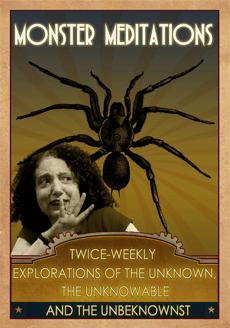Sometimes a storyteller must be sneaky and sprinkle false clues —AKA “red herrings” among the “useful” bits and pieces of information in a work of fiction. The best mystery writers are adept at this kind of misdirection. The seemingly casual mention of a dog barking every night at a particular time, a observation about a character arriving late for an appointment, or a detailed description of the items on a desk could be clues to solve the mystery OR false clues meant to draw the readers attention away from the woman who lets her cat out at exactly that time each night, the arrival of another character earlier than expected for the same meeting or an item that is missing from the list of stuff on the desk.
It’s like a magician saying —“Watch the coin in my left hand.” So you don’t see the flower in his right hand —sleight of word tricks!
My agent/writing guru/primary critic & cheerleader once used the phrase “Hang a lantern on it.” It’s a term in screenwriting, usually describing a visual cue/clue in the script that calls subtle attention to a particular action that will later turn out to be important. Show the character looking under the sofa for the missing broach. He may actually use that time to conceal the purloined jewelry inside the cat bed beside couch, but this doesn’t come out until later.
Somewhere along the line, in my twisted imagination, I conflated RED HERRING and HANG A LANTERN into my personal —HANG A RED LANTERN credo. Now, when I want to throw suspicion on an innocent character I hang a red lantern on an action or have them say something that could be misinterpreted by the protagonist.
That’s the game I’m playing right now. The principal character in my newest-in-progress is young and, although she is bright and well educated, she is naïve because of her lack of life experience. I want to her to suspect nefarious motives on the part of a genuinely good person while trusting a few less-than-savory characters in the mix.
It’s time to smoke some herrings, light up the lanterns and have some fun!
Link for more information on how Red Herrings got their fishy name…





I love foreshadowing in all its forms! That’s one reason I could never publish a story in a true, serial form – i.e. publishing as I write. Even on my best days, when the creativity is running in top gear, I can’t get all the nuances and important bits down properly. I need to see the whole story in order to go back and fill in the feather strokes of foreshadowing. Or fix a gaping plot hole I didn’t notice…. 🙁
I’m with you on that!
I’ll never be able to participate in that write a novel in a month thing, because I have to keep going back and fixing and changing and moving around and reconsidering and… as I go. I’m definitely a pantser, but that doesn’t mean I don’t have a direction — it just means I don’t have a map.
In the realm of Red Herrings and false clues, I seed them as I go, but I have to go back and make sure some of those seeds are watered enough to grow.
Happy planting of clues to you!
This couldn’t have come at a better time. I’m writing a crime mystery, and trying to leave clues or throw the reader off regarding the outcome. It’s a bit tricky for me, because this is my first crime mystery.
Good luck with your newest-in-progress!
Sometimes my timing is good!
The mix of real clues and faux clues is an essential part of any crime fiction story. My objective is for the reader to say, “I should have seen it! But somehow I missed it.” Rather than, “I’m mystified” or “It was just too obvious.” Agatha Christie was the goddess of misdirection demonstrated in actions, time, places, clothes, etc. Whereas, writers with a more psychological bent, Ruth Rendell for instance, rely more on a character’s individual deceptions. In her short novel “A Sleeping Life” the murder victim’s deceptions are the nexus of the crime. It’s a brilliant example of sneaky writer tricks at work.
If my pondering has been of any help to you, I’m very happy!
Smoked herring has never been on my list of favorites. I always preferred sardines in mustard instead. But this has nothing to do with what you were talking about really.
Tying in the clues is always a strange experience. Even when it isn’t exactly mystery I write, I still find keeping things a bit in the dark at times is one of the tools we have that helps to build tension. Shining light on things that might or might not be important helps to give a sense of unbalance that works great in the horrors that come out of the depths of darkness.
I like the sardines on a plate and the smoked red herrings in the story.
Yes, it is about creating a sense of “unbalance.” Great way to put it!